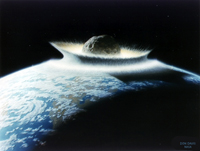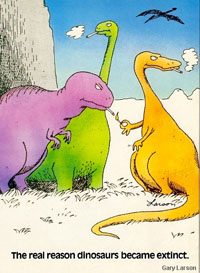2.17: Evidence of Large Mass Extinctions Preserved In the Fossil Record
- Page ID
- 9785
\( \newcommand{\vecs}[1]{\overset { \scriptstyle \rightharpoonup} {\mathbf{#1}} } \)
\( \newcommand{\vecd}[1]{\overset{-\!-\!\rightharpoonup}{\vphantom{a}\smash {#1}}} \)
\( \newcommand{\id}{\mathrm{id}}\) \( \newcommand{\Span}{\mathrm{span}}\)
( \newcommand{\kernel}{\mathrm{null}\,}\) \( \newcommand{\range}{\mathrm{range}\,}\)
\( \newcommand{\RealPart}{\mathrm{Re}}\) \( \newcommand{\ImaginaryPart}{\mathrm{Im}}\)
\( \newcommand{\Argument}{\mathrm{Arg}}\) \( \newcommand{\norm}[1]{\| #1 \|}\)
\( \newcommand{\inner}[2]{\langle #1, #2 \rangle}\)
\( \newcommand{\Span}{\mathrm{span}}\)
\( \newcommand{\id}{\mathrm{id}}\)
\( \newcommand{\Span}{\mathrm{span}}\)
\( \newcommand{\kernel}{\mathrm{null}\,}\)
\( \newcommand{\range}{\mathrm{range}\,}\)
\( \newcommand{\RealPart}{\mathrm{Re}}\)
\( \newcommand{\ImaginaryPart}{\mathrm{Im}}\)
\( \newcommand{\Argument}{\mathrm{Arg}}\)
\( \newcommand{\norm}[1]{\| #1 \|}\)
\( \newcommand{\inner}[2]{\langle #1, #2 \rangle}\)
\( \newcommand{\Span}{\mathrm{span}}\) \( \newcommand{\AA}{\unicode[.8,0]{x212B}}\)
\( \newcommand{\vectorA}[1]{\vec{#1}} % arrow\)
\( \newcommand{\vectorAt}[1]{\vec{\text{#1}}} % arrow\)
\( \newcommand{\vectorB}[1]{\overset { \scriptstyle \rightharpoonup} {\mathbf{#1}} } \)
\( \newcommand{\vectorC}[1]{\textbf{#1}} \)
\( \newcommand{\vectorD}[1]{\overrightarrow{#1}} \)
\( \newcommand{\vectorDt}[1]{\overrightarrow{\text{#1}}} \)
\( \newcommand{\vectE}[1]{\overset{-\!-\!\rightharpoonup}{\vphantom{a}\smash{\mathbf {#1}}}} \)
\( \newcommand{\vecs}[1]{\overset { \scriptstyle \rightharpoonup} {\mathbf{#1}} } \)
\( \newcommand{\vecd}[1]{\overset{-\!-\!\rightharpoonup}{\vphantom{a}\smash {#1}}} \)
\(\newcommand{\avec}{\mathbf a}\) \(\newcommand{\bvec}{\mathbf b}\) \(\newcommand{\cvec}{\mathbf c}\) \(\newcommand{\dvec}{\mathbf d}\) \(\newcommand{\dtil}{\widetilde{\mathbf d}}\) \(\newcommand{\evec}{\mathbf e}\) \(\newcommand{\fvec}{\mathbf f}\) \(\newcommand{\nvec}{\mathbf n}\) \(\newcommand{\pvec}{\mathbf p}\) \(\newcommand{\qvec}{\mathbf q}\) \(\newcommand{\svec}{\mathbf s}\) \(\newcommand{\tvec}{\mathbf t}\) \(\newcommand{\uvec}{\mathbf u}\) \(\newcommand{\vvec}{\mathbf v}\) \(\newcommand{\wvec}{\mathbf w}\) \(\newcommand{\xvec}{\mathbf x}\) \(\newcommand{\yvec}{\mathbf y}\) \(\newcommand{\zvec}{\mathbf z}\) \(\newcommand{\rvec}{\mathbf r}\) \(\newcommand{\mvec}{\mathbf m}\) \(\newcommand{\zerovec}{\mathbf 0}\) \(\newcommand{\onevec}{\mathbf 1}\) \(\newcommand{\real}{\mathbb R}\) \(\newcommand{\twovec}[2]{\left[\begin{array}{r}#1 \\ #2 \end{array}\right]}\) \(\newcommand{\ctwovec}[2]{\left[\begin{array}{c}#1 \\ #2 \end{array}\right]}\) \(\newcommand{\threevec}[3]{\left[\begin{array}{r}#1 \\ #2 \\ #3 \end{array}\right]}\) \(\newcommand{\cthreevec}[3]{\left[\begin{array}{c}#1 \\ #2 \\ #3 \end{array}\right]}\) \(\newcommand{\fourvec}[4]{\left[\begin{array}{r}#1 \\ #2 \\ #3 \\ #4 \end{array}\right]}\) \(\newcommand{\cfourvec}[4]{\left[\begin{array}{c}#1 \\ #2 \\ #3 \\ #4 \end{array}\right]}\) \(\newcommand{\fivevec}[5]{\left[\begin{array}{r}#1 \\ #2 \\ #3 \\ #4 \\ #5 \\ \end{array}\right]}\) \(\newcommand{\cfivevec}[5]{\left[\begin{array}{c}#1 \\ #2 \\ #3 \\ #4 \\ #5 \\ \end{array}\right]}\) \(\newcommand{\mattwo}[4]{\left[\begin{array}{rr}#1 \amp #2 \\ #3 \amp #4 \\ \end{array}\right]}\) \(\newcommand{\laspan}[1]{\text{Span}\{#1\}}\) \(\newcommand{\bcal}{\cal B}\) \(\newcommand{\ccal}{\cal C}\) \(\newcommand{\scal}{\cal S}\) \(\newcommand{\wcal}{\cal W}\) \(\newcommand{\ecal}{\cal E}\) \(\newcommand{\coords}[2]{\left\{#1\right\}_{#2}}\) \(\newcommand{\gray}[1]{\color{gray}{#1}}\) \(\newcommand{\lgray}[1]{\color{lightgray}{#1}}\) \(\newcommand{\rank}{\operatorname{rank}}\) \(\newcommand{\row}{\text{Row}}\) \(\newcommand{\col}{\text{Col}}\) \(\renewcommand{\row}{\text{Row}}\) \(\newcommand{\nul}{\text{Nul}}\) \(\newcommand{\var}{\text{Var}}\) \(\newcommand{\corr}{\text{corr}}\) \(\newcommand{\len}[1]{\left|#1\right|}\) \(\newcommand{\bbar}{\overline{\bvec}}\) \(\newcommand{\bhat}{\widehat{\bvec}}\) \(\newcommand{\bperp}{\bvec^\perp}\) \(\newcommand{\xhat}{\widehat{\xvec}}\) \(\newcommand{\vhat}{\widehat{\vvec}}\) \(\newcommand{\uhat}{\widehat{\uvec}}\) \(\newcommand{\what}{\widehat{\wvec}}\) \(\newcommand{\Sighat}{\widehat{\Sigma}}\) \(\newcommand{\lt}{<}\) \(\newcommand{\gt}{>}\) \(\newcommand{\amp}{&}\) \(\definecolor{fillinmathshade}{gray}{0.9}\)Evidence of Large Mass Extinctions Preserved In the Fossil Record
Extinction is the state or process of a species, family, or larger group being or becoming extinct (ceasing to exist).
Extensive studies of microfossils in deep well cores extracted from around the world show that the appearance and disappearance (extinction) of species has happened continuously through geologic time, but the rate was not constant.
As climates and landscapes changed, new species evolved to fit ever changing ecological niches; older species fade away.
A mass extinction is an episode or event in earth history where large numbers of species vanish from the fossil record nearly simultaneously. The causes of mass extinctions are debated, but some are linked to possible global climate changes associated with asteroid impacts, massive volcanism episodes, onset of ice ages, or a combination of effects that affected environments globally. Many questions remain about the causes of the great mass extinctions (because they may shed light on what is happening or may happen to the world related to human activities impacting the modern environment).
Current estimates are that 90 percent of all species that have ever lived on Earth are now extinct. However, the rate of extinction has not been constant. Mass extinctions have occurred at least five times in the last 500 million years. With each mass extinction much as about 50 to 90 percent of previously existing species on Earth had disappeared in very short periods of geologic time (Figure 2.38).

Figure 2.38. Great mass extinction events in the fossil record (species diversity compared with the geologic time scale).
The Permian/Triassic (P/T) Boundary Extinction—The Greatest Of All Mass Extinctions
The greatest mass extinction event occur at the end of the Permian Period (about 252 million years ago). Most families of organisms that existed in the Paleozoic Era vanished at the end of the Permian Period. A 2008 report published by the Royal Society of London provided estimates that as much as 96 percent of marine species and about 70 percent of terrestrial vertebrates that existed in Late Permian time vanished during the end of the Permian extinction event. This occurred during the assembly and breakup of the supercontinent Pangaea. Great amounts of volcanism are known from that period associated with the rifting and opening of the Atlantic Ocean basin. However, other causes, such as glaciation, ocean circulation collapse, or possibly asteroid and comet impacts, extraterrestrial radiation events, and others have been pondered. The problem with studying mass extinctions like the one associated with the Permian-Triassic boundary is that the world has significantly changed since that time. Bedrock of Permian and older age under all the world's ocean basins have be subducted back into the Earth's mantle or heavily altered by mountain-building processes. In addition, much of the sedimentary record associated with exposed land of that time were stripped away by erosion before sediments began to be deposited and preserved in Triassic Period. Whatever the cause, it took many millions of years after the P/T extinction event (or events) for the biodiversity of the planet to return to levels that existed before in the Late Paleozoic Era. When this biodiversity returned, the world was host to completely different varieties of species and ecological communities, many replacing or occupying the same life habits (niches) and environments occupied by organisms that disappeared before the P/T extinction.
Great extinction events created opportunity for new life-forms to emerge. For instance, dinosaurs and many other life forms appeared only after the mass extinction at the end of the Permian Period (about 252 million years ago). The same is true for when mammals replaced dinosaurs when they went extinct at the end of the Cretaceous Period.
Perhaps the most studied extinction event has been the Cretaceous-Tertiary Boundary where strong evidence suggests at least one asteroid collided with earth in the vicinity of the Yucatan Peninsula in Mexico (about 66 million years ago)(Figure 2.39, see Figure 2.58 below). This extinction killed off the dinosaurs and many other families of organism that lived in the oceans and on land. However, the catastrophe made room for mammals and other groups of organisms to rapidly diversify and evolve. Unlike the P/T extinction which has limited exposure around the world from 252 million years ago, there are many locations world wide and on all continents and within sediments extracted from the sea floor that reveal information about what happened at the end of the Cretaceous Period about 66 to 65 million years ago (discussed below).
 |
 |
| Figure 2.39. An massive asteroid impact can ruin your day (and your species, and many others). | Figure 2.40. A classic Far Side cartoon by Gary Larson. |
Are humans causing a sixth great mass extinction?
Many scientists believe evidence suggests that another mass extinction is currently under way. Global climate change, the growth of the human population, and the expansion of human activity into previously wild habitats are largely to blame. Some estimates suggest that human activities such as land clearing (for agriculture), pollution, mining, urban development, and over fishing may drive more than half of the world's marine and land species to extinction possibly within the next century. This extinction event perhaps began during the end of the last ice age when humans spread around the globe and their populations expanded when the global climate was drastically changing. Many species of large land animals and birds have vanished in the past 10,000 years, but the rate of changes has drastically increased in the past 100 years with the tremendous expansion in the global human population.


